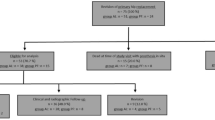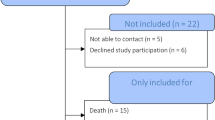Abstract
Purpose
The purpose of this study was to assess the clinical outcomes, complications, and survival of a long cementless titanium femoral stem in revision total hip arthroplasty (THA) at a minimum five year follow-up.
Methods
Between 2000 and 2010, 114 patients (116 hips), with a mean age of 68 ± 12 years, underwent revision THA using a KAR® stem (DePuy, Leeds, UK). The main reasons for revision were aseptic loosening (82%), periprosthetic joint infections (PJI) (11%), and periprosthetic fractures (6%). Mean follow-up was ten ± three years (range, 5–16). Harris Hip Score (HHS), Oxford Hip Score (OHS), and Postel-Merle d’Aubigné (PMA) score were recorded. Radiographic analysis assessed stem osseointegration and subsidence. Survival was analyzed using the Kaplan-Meier (KM) method and cumulative incidence function (CIF).
Results
Post-operative HHS was 83 ± 15 (range, 35–99) and OHS was 37 ± 8 (range, 8–48). PMA score significantly increased from 12 ± 2 (range, 5–18) pre-operatively to 14.6 ± 2 (range, 9–18) post-operatively (p = 0.0004). The radiographic Engh score was 15 ± 8 (range, 7–22). Stem subsidence was observed in two cases (3%). At ten years, five stems had been revised, three for infections and two for periprosthetic fractures. Using the KM method, ten year survival free of stem revision for aseptic loosening was 100%, free of revision for any reason 95%, and free of any re-operation 81%.
Conclusions
The present study reported satisfactory outcomes and survival of a long tapered unlocked cementless femoral stem in revision THA at a minimum follow-up of five years.






Similar content being viewed by others
References
Haynes JA, Stambough JB, Sassoon AA et al (2015) Contemporary surgical indications and referral trends in revision total hip arthroplasty: a 10-year review. J Arthroplast 31:622–625
Pinaroli A, Lavoie F, Cartillier JC et al (2009) Conservative femoral stem revision: avoiding therapeutic escalation. J Arthroplast 24:365–373
Hartman CW, Garvin KL (2012) Femoral fixation in revision total hip arthroplasty. Instr Course Lect 61:313–325
Smith MA, Deakin AH, Allen D et al (2016) Midterm outcomes of revision total hip arthroplasty using a modular revision hip system. J Arthroplast 31:446–450
Hoberg M, Konrads C, Engelien J et al (2015) Outcome of a modular tapered uncemented titanium femoral stem in revision hip arthroplasty. Int Orthop 39:1709–1713
Kim YH, Park JW, Kim JS et al (2015) High survivorship with cementless stems and cortical strut allografts for large femoral bone defects in revision THA. Clin Orthop Relat Res 473:2990–3000
Thomsen PB, Jensen NJ, Kampmann J et al (2013) Revision hip arthroplasty with an extensively porous-coated stem - excellent long-term results also in severe femoral bone stock loss. Hip Int 23:352–358
Della Valle CJ, Paprosky WG (2004) The femur in revision total hip arthroplasty evaluation and classification. Clin Orthop Relat Res 55–62
Engh CA, Massin P, Suthers KE (1990) Roentgenographic assessment of the biologic fixation of porous-surfaced femoral components. Clin Orthop Relat Res 107–128
Biau DJ, Latouche A, Porcher R (2007) Competing events influence estimated survival probability: when is Kaplan-Meier analysis appropriate? Clin Orthop Relat Res 462:229–233
Solomon LB, Costi K, Kosuge D et al (2015) Revision total hip arthroplasty using cemented collarless double-taper femoral components at a mean follow-up of 13 years (8 to 20): an update. Bone Joint J 97-B:1038–1045
Carrera L, Haddad S, Minguell J et al (2015) Mid-term outcomes and complications with cementless distal locking hip revision stem with hydroxyapatite coating for proximal bone defects and fractures. J Arthroplast 30:1035–1040
Ferreira A, Aslanian T, Dalin T et al (2017) Ceramic bearings with bilayer coating in cementless total hip arthroplasty. A safe solution A retrospective study of one hundred and twenty six cases with more than ten years’ follow-up. Int Orthop 41:893–899
Schmolders J, Amvrazis G, Pennekamp PH et al (2017) Thirteen year follow-up of a cementless femoral stem and a threaded acetabular cup in patients younger than fifty years of age. Int Orthop 41:39–45
Imbuldeniya AM, Walter WK, Zicat BA et al (2014) The S-ROM hydroxyapatite proximally-coated modular femoral stem in revision hip replacement: results of 397 hips at a minimum ten-year follow-up. Bone Joint J 96:730–736
Mertl P, Philippot R, Rosset P et al (2011) Distal locking stem for revision femoral loosening and peri-prosthetic fractures. Int Orthop 35:275–282
Canovas F, Putman S, Girard J et al (2018) Global radiological score for femoral cementless revision stem. Int Orthop 42:1007–1013
Roche O, Girard J, Canovas F et al (2016) Assessment of fixation in cementless femoral revision of total hip arthroplasty: comparison of the Engh score versus radiolucent line measurement. Int Orthop 40:907–912
Sanli I, Arts JJ, Geurts J (2015) Clinical and radiologic outcomes of a fully hydroxyapatite-coated femoral revision stem: excessive stress shielding incidence and its consequences. J Arthroplast 31:209–214
Makani A, Kim TW, Kamath AF et al (2014) Outcomes of long tapered hydroxyapatite-coated stems in revision total hip arthroplasty. J Arthroplast 29:827–830
Demey G, Fary C, Lustig S et al (2011) Does a collar improve the immediate stability of uncemented femoral hip stems in total hip arthroplasty? A bilateral comparative cadaver study. J Arthroplast 26:1549–1555
Khatod M, Cafri G, Inacio MC et al (2015) Revision total hip arthoplasty: factors associated with re-revision surgery. J Bone Joint Surg Am 97:359–366
Springer BD, Fehring TK, Griffin WL et al (2009) Why revision total hip arthroplasty fails. Clin Orthop Relat Res 467:166–173
Ponzio DY, Shahi A, Park AG et al (2015) Intraoperative proximal femoral fracture in primary cementless total hip arthroplasty. J Arthroplast 30:1418–1422
Viste A, Desmarchelier R, Fessy MH (2017) Dual mobility cups in revision total hip arthroplasty. Int Orthop 41:535–542
Mohaddes M, Cnudde P, Rolfson O et al (2017) Use of dual-mobility cup in revision hip arthroplasty reduces the risk for further dislocation: analysis of seven hundred and ninety one first-time revisions performed due to dislocation, reported to the Swedish Hip Arthroplasty Register. Int Orthop 41:583–588
Tetreault MW, Shukla SK, Yi PH et al (2014) Are short fully coated stems adequate for “simple” femoral revisions? Clin Orthop Relat Res 472:577–583
Hultmark P, Karrholm J, Stromberg C et al (2000) Cemented first-time revisions of the femoral component: prospective 7 to 13 years’ follow-up using second-generation and third-generation technique. J Arthroplast 15:551–561
Vidalain JP (2011) Twenty-year results of the cementless Corail stem. Int Orthop 35:189–194
Author information
Authors and Affiliations
Corresponding author
Ethics declarations
Conflict of interest
MHF perceives royalties from DePuy and Serf, not related to the current study. AV, HB, RD, and YH have no conflict of interest.
Rights and permissions
About this article
Cite this article
Herry, Y., Viste, A., Bothorel, H. et al. Long-term survivorship of a monoblock long cementless stem in revision total hip arthroplasty. International Orthopaedics (SICOT) 43, 2279–2284 (2019). https://doi.org/10.1007/s00264-018-4186-2
Received:
Accepted:
Published:
Issue Date:
DOI: https://doi.org/10.1007/s00264-018-4186-2




